Lust, Women, and the Devil: Seven Decades of Fritz Leiber’s Conjure Wife
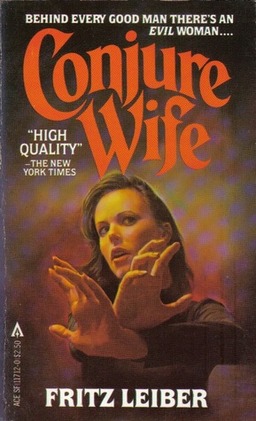 There are a lot of fascinating things you can learn about 20th Century America — and America today — by being a compulsive paperback collector. Seriously. It’s like being a Cultural Anthropologist.
There are a lot of fascinating things you can learn about 20th Century America — and America today — by being a compulsive paperback collector. Seriously. It’s like being a Cultural Anthropologist.
Let’s take a look at Fritz Leiber’s first novel, Conjure Wife. In fact, it’s a near perfect example. The book has been reprinted around a dozen times by roughly as many publishers over the last 70 years, and each time the cover art and marketing copy tell you as much about society as they do about the book. More, even.
First, it helps to know a little about the novel. Conjure Wife was written in 1943; it’s a supernatural horror novel that imagines that witchcraft is an ancient secret shared by most women. Our protagonist Norman Saylor, a professor at a small town college, accidentally discovers that his wife Tansy is a witch. When he convinces her to abandon the mysterious art, the couple rapidly find their luck changing for the worse. Turns out that Tansy’s various charms were the only thing protecting them from an intricate web of curses and counter-spells cast by the women around them.
I always thought that was a fascinating premise. If it seems familiar, it’s because the story has filtered into public consciousness since 1943 — it’s been filmed at least three times: the Lon Chaney, Jr. feature Weird Woman (1944), the Charles Beaumont and Richard Matheson collaboration Burn, Witch, Burn! (1962), and Lana Turner’s final film, Witches’ Brew (1980). Of course, the concept of a community of witches and warlocks living secretly among us has gradually become a popular fantasy trope — used in Jimmy Stewart’s 1958 fantasy Bell, Book and Candle, just for example, as well as the 1964 to 1972 TV series Bewitched, and even the Harry Potter novels.
Conjure Wife touches on some powerful themes: the power imbalance between the sexes, the suspicion and raw fear with which men view female sexuality, and the willful ignorance men are capable of when confronted with the community of women — especially when it comes to anything that looks like shared wisdom and knowledge. Every generation has viewed this book very differently and how publishers packaged it for the American public offers us fascinating raw insight into the way this country has changed over the last 70 years.
Let’s start with the novel’s first appearance, in the April 1943 issue of John W. Campbell’s famous pulp magazine Unknown Worlds.
I know; pics or it didn’t happen. Here’s the cover:
And here’s the blurb, printed right on the cover of the magazine, for those whose eyes aren’t quite stellar enough to make it out:
All women carry handbags as big as young suitcases, full of bits of this — oddments of that. Powder and rouge and lipstick, recipes and formulas. But — maybe those formulas aren’t all cake and cookies recipes. Maybe not all those powders are cosmetics. A bit of magic, a little witchcraft, mixed in– graveyard dirt and perfume, formulas for Dottie’s Cake and How To Steal a Soul —
This is fascinating. What’s the most mysterious and inexplicable thing about women in 1943? What do they keep in their handbags? What can all those unguessable ointments and powders be for?
Witchcraft. It’s the only thing that makes sense.
And now we fast-forward a decade, emerging from the fog of World War II, to America in the early 1950s. See if you can notice any difference in the way the story is being marketed in the 1953 Lion paperback, with a sultry cover by Robert Maguire:
Yes, the book is now being packaged as a gothic romance, with a wind-blasted heath in the foreground and a dark tower in the distance. That’s different.
But there’s more to it than that. Let’s focus on that cover text:
Potions in the House…
Evil in the Air…
And a Witch in his Bed
Suddenly the story is about sex. And evil. The two are intimately connected, in fact.
This book isn’t about trying to figure out what women have in their purse. It’s about what dark mysteries lurk in a woman’s bed. Our everyman hero Norman Saylor is all unknowingly sleeping with an agent of evil.
Let’s take a break for a moment to look at the 1962 Berkley Medallion paperback, a tie-in to the release of Burn, Witch, Burn! that same year.
Nothing really wrong with this cover, except it’s selling the movie, not the book, so it’s not all that germane to our discussion. Still, it’s here for the sake of completeness. And because I don’t own a copy of this edition, and I want one.
Much more interesting, I think, is the 1968 paperback from Award Books, which continues the evolution of the marketing of Conjure Wife with a beautiful and sensual cover by Jeff Jones — perhaps my favorite cover of the lot.
It’s fifteen years after Lion edition, and we’re still clearly in the province of gothic romance. There’s even a castle in the background. Just for the record, there is no castle in this book. It’s set in New England. Tansy Saylor is wearing an entire king-size sheet set, and she still manages to look almost naked.
But I’m more interested in the cover text. Once more, there’s been a subtle but crucial shift in the marketing copy. Again, see if you can notice it.
Dark Shadows of Evil Trapped
Her in a Web of Witchcraft —
A Modern Classic of Terror and Suspense
Suddenly we’re talking about Tansy instead of Norman. According to this cover, Conjure Wife isn’t about a man who discovers a witch in his bed. It’s about a heroine struggling against an evil heritage. Plus: sex.
The description on the first page falls a little more in line with what we know about the book.
Maybe All Women Were Witches…
Half of the human race still actively practicing sorcery? Thee witch women using magic — as had his wife — to advance their husbands’ careers and their own? Making use of their husbands’ special knowledge to give magic a modern twist. Competing with each other. Testing the powers of their charms and spells. Destroying each other by invoking ancient evils…
And he had rendered his wife helpless against them by forcing her to stop!
The back cover is fascinating as well, as it reprints a quote from Damon Knight’s rave review of the book, focusing on the “sickly growth, uncultivated, unsuspected,” of modern witchcraft (see the whole thing here.)
The name Tansy, by the way — as pointed out by my inscrutable, rich-with-hidden-knowledge wife — is also the name of an herb used by women in the Middle Ages to improve fertility and prevent miscarriages. Make of that what you will; Alice wouldn’t give up any more secret insight.
And now we leap ahead another decade, to the 1977 Ace reprint. Gone are all the trappings of the gothic romance. Conjure Wife is abruptly a very different thing altogether: a horror novel.
Once again, Tansy is the villain. The hero is Norman Saylor, and what he’s up against is nothing less than a pervasive and ancient cabal of evil women, passing their secret knowledge down through the generations. Here’s the back cover text:
Such an enchanting wife…
The faculty members of solid old Hampnell College — male — think that they are well in control of their own fates. Their wives know better. The entire structure of Hempnell rests on the ancient and potent magicks that all women know, and all men deny.
Tansy Saylor has done well by her Norman — so far. But now he has discovered her occult machinations, and demanded that she give up such childish nonsense. How is he to know that he has opened the door to a power so ancient, so malevolent, that all of Tansy’s might had been required to bind it — and all the might in the world may not be enough to bar the door again.
“Easily the most frightening (and necessarily) the most thoroughly convincing of all modern horror stories… Leiber has never written anything better.” — Damon Knight
While we’re finally getting closer to a true representation of the book — horror, not gothic romance — I’m still a little surprised that the 1977 version isn’t more sympathetic to Tansy.
The evil-Tansy approach is even more apparent in the 1984 reprint, also from Ace:
I don’t particularly like this cover, but I do think it’s the purest distillation yet of one of the questions at the heart of this book: what is the nature of the sexual power of women? Where does it originate from?
From the devil. Duh.
I am amazed how this book (or, much more accurately, the packaging of this book) has consistently — for generations — sent the message to heterosexual men that they aren’t to blame for their sexual desires. Women — all women — possess secret and evil gifts for the manipulation of men.
Men, your desire springs from an unholy source. Your nature remains pure, and the vessel of sin (in case you didn’t get any of the many previous memos) is women. Just FYI.
All this to help sell a paperback.
Finally, we come to the modern trade paperback edition, published by Tor/Orb in September, 2009 with a cover by Chris McGrath.
Two decades of female-positive urban fantasy cover images have made another evolution possible in the packaging of Conjure Wife. Here we find Tansy Saylor portrayed, not as the hapless wife needing guidance of 1953, or the innocent ingenue in the grip of the forces of evil from 1968, or the evil villainness of 1977. Instead, she is assured and powerful, confident in her sexual power and exploring the other sources of power at her disposal.
Here’s the back cover copy, which I think suits this edition nicely:
Professor Norman Saylor considered magic nothing more than superstition. Then he learned that his own wife was a practicing sorceress. But he still refuses to accept the truth… that in the secret occult warfare that governs our lives, magic is a matter of life and death. And that unbeknownst to men, every woman knows it.
Filmed twice, as Weird Woman (1944) and Burn Witch Burn (1961), this tale of secret witchcraft on a modern college campus is as readable today as the day it was written.
I’m sure the interpretation of Conjure Wife has not stopped evolving, and I’m curious to see how it will be marketed in another 20 or 40 years. Perhaps as a comedy featuring a hapless husband, like Bewitched? A young adult thriller?
A new film version was announced way back in 2008, to be directed by Billy Ray. I have no idea if it’s still in development or not. It might be fun to compare the movie versions, too. But I collect paperbacks, not movies. Maybe Ryan Harvey or Goth Chick will do it.
Want a copy of Conjure Wife? You’ve got many editions to choose from. Most are available cheaply online in one outlet or another. If you want a new copy, I recommend the handsome Orb trade paperback, which I bought remaindered for $6 from Amazon. Copies are still available if you act quickly.
Goodreads has a more comprehensive survey of about a dozen different editions of the novel here.
If you’re interested in reading more about Unknown magazine and the great fiction it published during its brief life, we discussed it in some length in December.
The last time we surveyed the covers of a single novel was Murray Leinster’s The Pirates of Zan. Read all of our recent Vintage Treasures articles here.
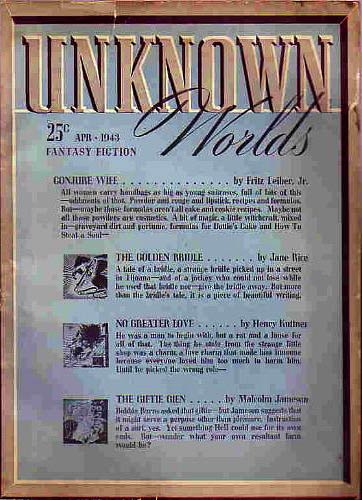
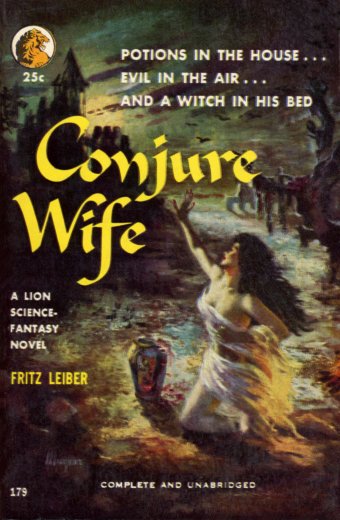
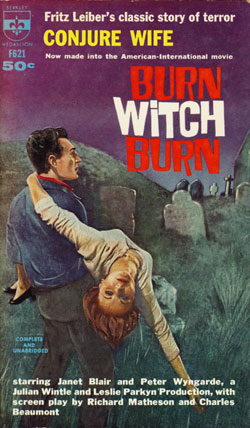
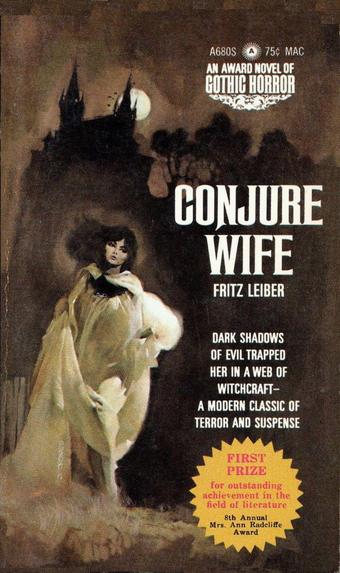
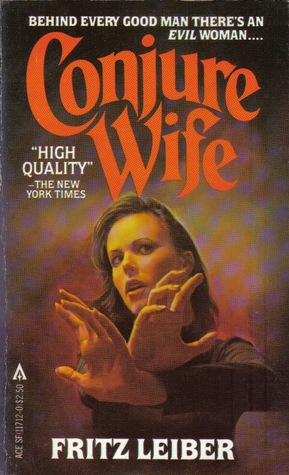

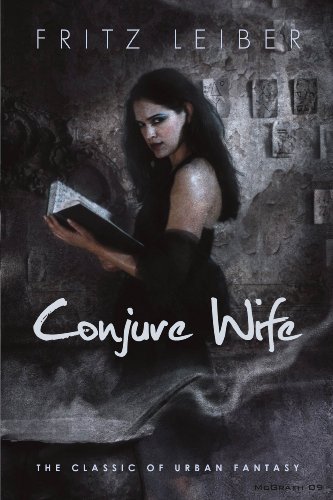
“[B]eing a compulsive paperback collector . . . [is] like being a Cultural Anthropologist.” I think that though really nails my own fascination with collecting old books and magazines.
I have a ’91 Tor paperback of Conjure Wife that packages it with Our Lady of Darkness. Interestingly enough, no woman appears on the cover.
I read the novel in the 1977 Ace edition (sadly I no longer own it). That lack of sympathy to Tansy (as opposed to what the story actually does) surprised me.
It’s been a few years since I read it, but I think there is a fascinating additional conjecture to be drawn from your wonderful overview here, John. As you illustrate, the marketing of the book is furthest off the mark at the earliest date, only gradually approaching the spirit of the text as the decades roll on from its first publication. If my memory serves me well, the way the book is marketed now — a hip, positive portrayal of the witch-wife — is truest to the nature of the text itself. On reflection, this is somewhat staggering, given the year 1943!
Lieber seems to be well ahead of his time socially on this one (which may be why, when I read it, I mistakenly thought it was one of his works from the ’60s). I don’t know enough about Fritz’s personal biography to know if he was a protofeminist or whatever, but clearly Tansy is portrayed in a strong, positive light. Norman is our sympathetic protagonist, but he is clearly dense — a learned college professor, no less! — and as clueless as everyone else of his gender in not recognizing the secret power of women.
The obvious analogy, conjured up in numerous iterations of packaging, is to equate this sorcerous power with sex, but if the text itself does this, it certainly does so subtly. One could just as well draw an analogy to the innate intelligence and abilities women possess that had so long been undervalued and overlooked while women were relegated to secondary roles (certainly still in Lieber’s day — that all these women are wives of professors, and not professors themselves, is certainly par for the times).
Of course, it was just when Lieber was writing this that the exigencies of war were making it necessary for women to move into jobs on the home front traditionally held down by men, quickly dispelling the notion that women are incapable of “man’s work.”
The secret witchcraft, as you mentioned, can also mirror the community and social skills that women, in general, have cultivated to a greater degree than men. In any case, Tansy could fit very easily into a contemporary urban fantasy series with a strong female fan base, and that is notable.
I’ve never read that novel so it’d be unfair to comment on it.
However, I LOVE the paperback covers over time. My prefs are the early 50s, late 60s, and 70s art. The 80s cover is laughable and dated vs timeless, only being exceeded in that by the 90s cover which isn’t even as laughable.
It’d be pretty neat to do some more articles with paperbacks over time, decades rather.
Also, don’t know if you’ve seen pulpcovers dot com but lots of 50s – 70s theme. (with before and after ones) A recent article here, well a few months ago, went lightly into the ‘post war paperback’ era aka the “Dime Novel” – which largely wasn’t our focus since sci-fi fantasy stuff wasn’t really touched. There were pirate stories, the un-married fathers of the modern “Romance” novel, and plenty of “Sword and Sandal” again mostly historical romances. (think “Sallambo”) There was also an …adult… under the counter thing, the 25c novel, most of these had lurid covers but little else, though some real greats wrote for it in secret to make $ and some emerged from it, such as Burroughs who’s novels helped free speech through their trials over censorship laws. Later, towards the 60s onwards, thanks in no small part to Lin Carter the paperback market boomed for sci-fi/fantasy from the magazines and comic books it had largely been confined in.
You mentioned in the comments to another post about gaps in your reading. This is one of my gaps. I’ve not read this one or Our Lady of Darkness, although I probably should some day. I do have a copy of the original Unknown it appeared in, though. Do you know if Conjure Wife was expanded for book publication?
> I think that though really nails my own fascination with collecting old books and magazines.
James,
I used to have a hard time articulating why I wanted to have multiple editions of the same book. Very few people understood it (certainly my long-suffering wife Alice didn’t), and I didn’t really understand it myself for a while.
This article is my attempt to put it in words. Few books demonstrate such a stark progression in their marketing through the years, but virtually every book is re-interpreted when the time comes to sell it to a new generation.
This article is partially inspired by Thomas Myer’s terrific post “Covering Heinlein,” which I published at the SF Site 17 years ago. It starts with the catchy opening:
> “Oh wow, that cover changes everything, the whole story,” my wife said. We were at our local Borders Bookstore, and she
> was looking at the 1997 Del Rey edition of Robert Heinlein’s Friday.
You can read the article here:
http://www.sfsite.com/vault/tom18.htm
> I read the novel in the 1977 Ace edition (sadly I no longer own it). That lack of sympathy to Tansy (as opposed to what the story actually does) surprised me.
Prince,
That was the aspect that most fascinated me: the vast swings in the way Tansy was portrayed over the decades. And not necessarily more positively as the decades progressed.
> It’s been a few years since I read it, but I think there is a fascinating additional conjecture to be drawn from your wonderful overview here, John…
> Tansy could fit very easily into a contemporary urban fantasy series with a strong female fan base, and that is notable.
Nick,
You’re absolutely right. I didn’t give Leiber nearly enough credit for writing a book that could speak to so many generations — including today’s casual readers, who expect a modern heroine. That’s an amazing accomplishment for something written in 1943.
> The 80s cover is laughable and dated vs timeless
Green,
I tend to agree. Strange to think that the 80s cover is the one which now seems the most out-of-date, but there it is.
> only being exceeded in that by the 90s cover which isn’t even as laughable.
I disagree. I think artist Chris McGrath delivered a powerful image for the Orb book, and I quite like it.
> I’ve not read this one or Our Lady of Darkness, although I probably should some day.
Keith,
I remember being disappointed when I first read OUR LADY OF DARKNESS 30 years ago. Probably because I was expecting a Stephen King-like horror epic, and the novel is much quieter than that. Definitely need to try it again as an adult.
> I do have a copy of the original Unknown it appeared in, though.
Jealous. I have very few issues of UNKNOWN.
> Do you know if Conjure Wife was expanded for book publication?
You know, I don’t, but I wondered the same thing. I didn’t come across any mention of a revision for paperback publication, but I wouldn’t be at all surprised.
I love this book, and I always think of it as the third part of a sort of thematic trilogy, along with Robert Heinlein’s “The Unpleasant Profession of Jonathan Hoag” and L. Ron Hubbard’s “Fear.” The books were published close to each other, and the three writers knew each other – they all came up in the pages of the John Campbell-edited magazines Astounding and Unknown. The three books share the theme of a battle between susperstition and rationalism, played out in an atmosphere of solipistic nightmare. I’ve always wondered just what the cross-influences were.
It was the 1968 edition that drew me to the novel. The cover text was particularly canny when it came to catching the eye of a preteen whose life mission it was to complete their Dark Shadows paperback collection!
With regard to the film adaptations, WEIRD WOMAN is fairly appalling in how it inverts the theme entirely, with professor Lon Chaney’s rational materialism proving the perfect cure for all those hysterical women surrounding him.
BURN WITCH BURN (NIGHT OF THE EAGLE) is better in that regard, but only just. It follows the story fairly closely, until the midpoint…then goes whirring off in its own direction, turning Tansy’s character into a weak cutout and throwing away the brilliant plot turns in favor of an extended chase scene. Perhaps the original would have been too difficult to translate to film, given that it’s all atmosphere, things half-glimpsed and internal voices. But it would be nice to see somebody try!
[…] follows as clear a path as, say, the changing women portrayed on the cover of Fritz Leiber’s Conjure Wife, but it’s still interesting to see the similarities in the way Pavane‘s core concepts […]
[…] Lust, Women, and the Devil: Seven Decades of Fritz Leiber’s Conjure Wife […]
[…] Review 1: https://www.blackgate.com/2014/02/15/lust-women-and-the-devil-seven-decades-of-fritz-leibers-conjure…https://www.blackgate.com/2014/02/15/lust-women-and-the-devil-seven-decades-of-fritz-leibers-conjure… […]
[…] Review 1: https://www.blackgate.com/2014/02/15/lust-women-and-the-devil-seven-decades-of-fritz-leibers-conjure…https://www.blackgate.com/2014/02/15/lust-women-and-the-devil-seven-decades-of-fritz-leibers-conjure… […]
[…] most recent edition, a Chris McGrath urban fantasy cover. And the novel can be all this and more. John O’Neill has an article about the many different covers of Conjure Wife at Black Gate and how they show both changing tastes in genres and cover design as well as how the view of women […]
Pretty late to the party here. I stumbled across this while doing background research for a podcast I’m hosting on the book and the movies.
Looks like the site is still a going concern, so I wonder if you’d be up for a short interview about this post that I could drop into my episode.